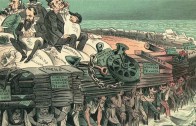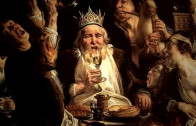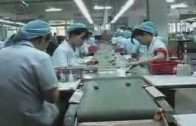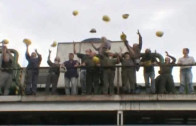Plutocracy
Plutocracy: Political Repression in the United States is a series of films that comprehensively examine early North American history through the lens of class, to enable a wider critique of the social construct in contemporary United States. The series not only documents and exemplifies individual strikes and labour movements throughout the centuries, but also serves to connect the narratives and political lessons of an entire era from a working-class viewpoint, forming a solid base of analysis for class struggle.
Series
The series starts by looking at the creation of early labour movements, citing Mary Harris Jones or ‘Mother Jones’–a schoolteacher and dressmaker who became a prominent labour and community organiser, coordinating major strikes and co-founding the Industrial Workers of the World. The context is also the forming of the American Constitution and Civil War draft riots, the ensuing industrialisation, consequent changes to police forces, robber barons, early American labour unions, and major mid-to-late 19th Century labour events including the uprising of 1877, the Haymarket Affair, Homestead strike and the New Orleans General Strike. This historical chronology also examines the West Virginian coal wars of the early 20th Century, culminating in the Battle of Blair Mountain–the largest labour uprising in United States history and one of the largest, well-organised, and well-armed uprisings since the American Civil War.
The second part of the series covers key labour-related events which occurred between the late 1800s and the 1920s. Its title refers to the song composed by Ralph Chaplin in 1915 as an anthem for unionised workers. The episode itself is the cinematic version of that anthem, providing a comprehensive understanding of the need for labour unions and the enormous sacrifices that are required to ensure fairness, safety, and equality. The operations of industries like railroads, steel and coal were characterised by slave labour, dangerous working environments, punishing hours, and child labour; but with the rise of labour unions, these industries were forced to re-examine their practices or run the risk of collapse altogether. One of the earliest examples of this is the formation of the American Railroad Union in 1893. The film shows how the Railroad Union won early successes in recovering wages for denigrated workers, where its popularity sky-rocketed among the working class. The capitalists soon fought back though, with their far-reaching strong-arm influence. Subsequent public strikes were met with extreme violence, oppression and unlawful arrests, illustrating some of the power dynamics central to class warfare in the fight for equality.
The clashes between workers’ rights and corporate interest are prominent in today’s political and economic landscape, but they’re not a modern phenomenon by any means. These imbalances, and the wealth inequalities that have resulted in their wake, have existed for generations. Part III unpacks this history by revealing portraits of brave workers who fought for true democracy in the early decades of the 20th century. The bulk of the film examines the impact of World War I on the labor movement, a conflict that saw the slaughter and disfigurement of a generation. The war provided further evidence of the class divide, and would propel labour advocacy efforts among all genders and races. All of this culminated in the rise of the Socialist Party and the radical International Workers of the World organisation, as well as the events of 1919, a year that saw almost a quarter of the entire workforce on strike. This episode offers invaluable historical insights from that time by a panel of historians and labour advocates.
By the 1900s, the United States become home of the bloodiest and most violent labour history of any industrial nation, in the world. This instalment covers some of the country’s most explosive struggles from 1920 to 1935, vividly capturing the interrelation between radical politics and class awareness. This episode details the West Virginia teachers rebellion, the tradition of worker-militancy going back to the great miners’ struggles that broke out after the First World War, all the way up to the General Strikes across Minneapolis, San Francisco and Toledo in 1934. Gangstas for Capitalism brings these and other historical recounts to life with lessons to inspire activism today–the most important being that we should never underestimate the ability of workers to demand social justice. The general strikes of 1934 involved mostly unskilled and semi-skilled workers, most of whom had little connection to, and even less faith in, ingrained and often conservative union traditions. As we’re seeing today, strikes will not always be waged with approval or material support of the union officialdom–solidarity from below will be key. While society has greatly evolved over the last 85 years, the fundamental element separating the rich from the rest of us–class inequality–still exists in spades. This episode celebrates the most powerful weapon oppressed people have: class organisation, and the power that can be leveraged through unity.
Subterranean Fire documents historically how the capitalist class have nefariously accumulated wealth and power by depriving working people of dignity and rights. This episode details at the outset how strike actions and popular revolts were put down by corporations through police, private detectives, vigilantes, and even the National Guard. For example, in the Homestead strike of 1892, after workers had defeated the Pinkerton agency’s private army, the National Guard was brought out. In 1929, 60 percent of the population lived well below the poverty line. Despite large increases in productivity, there was no trickle down of profits. Neither was there a social safety net. Subterranean Fire informs how unions sought to end prejudice–an obvious sine qua non in the battle between the moneyed power of the capitalist class and working class. Grotesque income and wealth disparity signifies the current state of neoliberalism, but this episode documents the push for change for working men and women, as union strength can be on the rebound.




